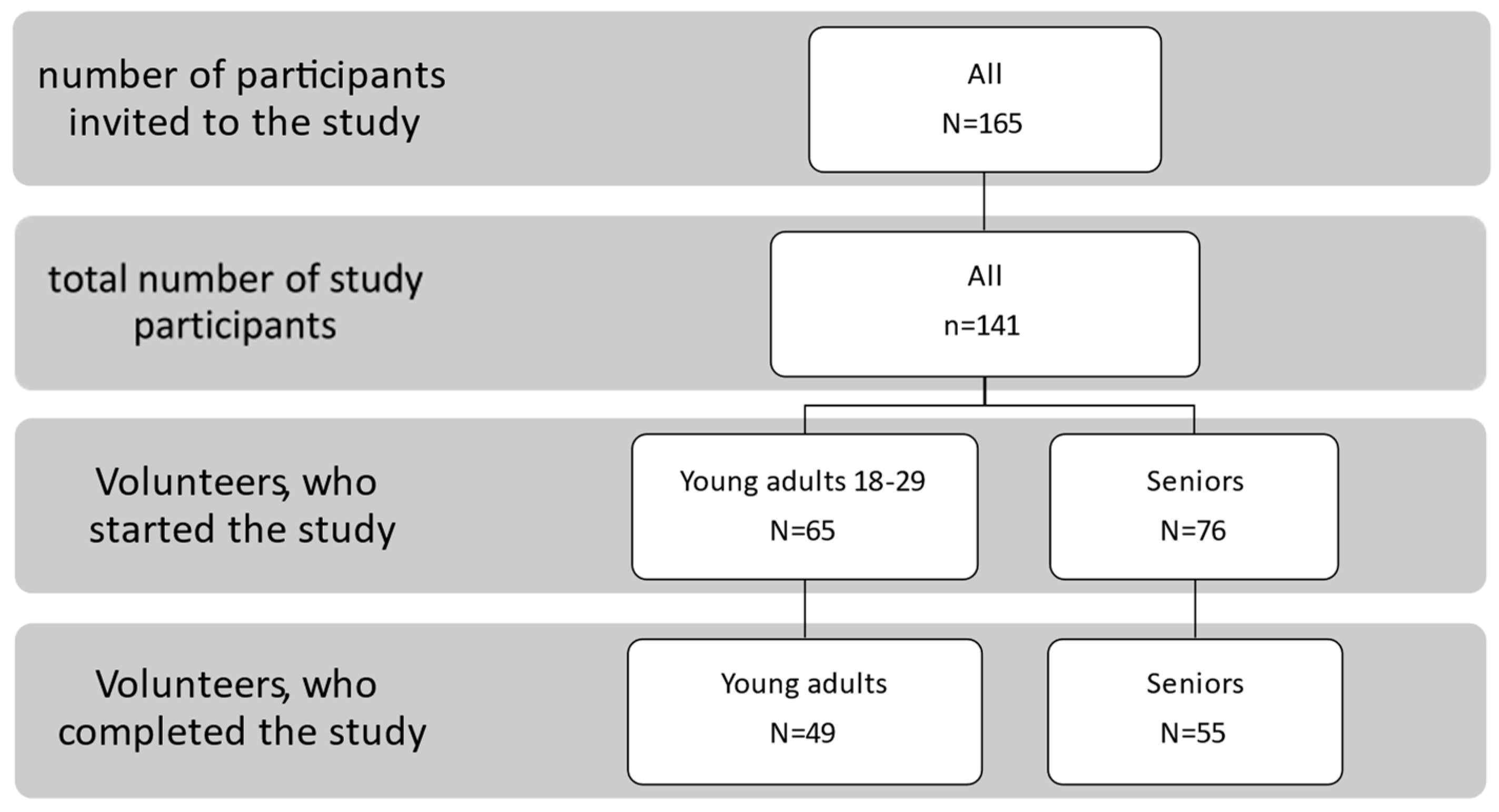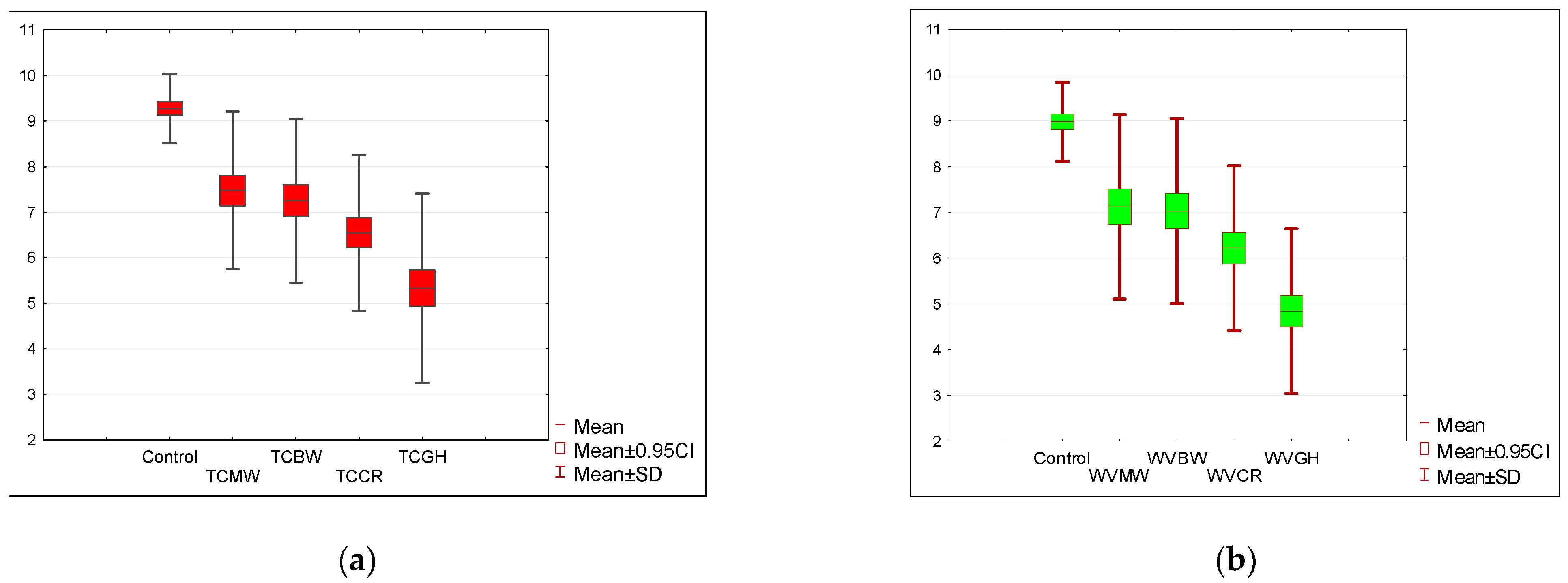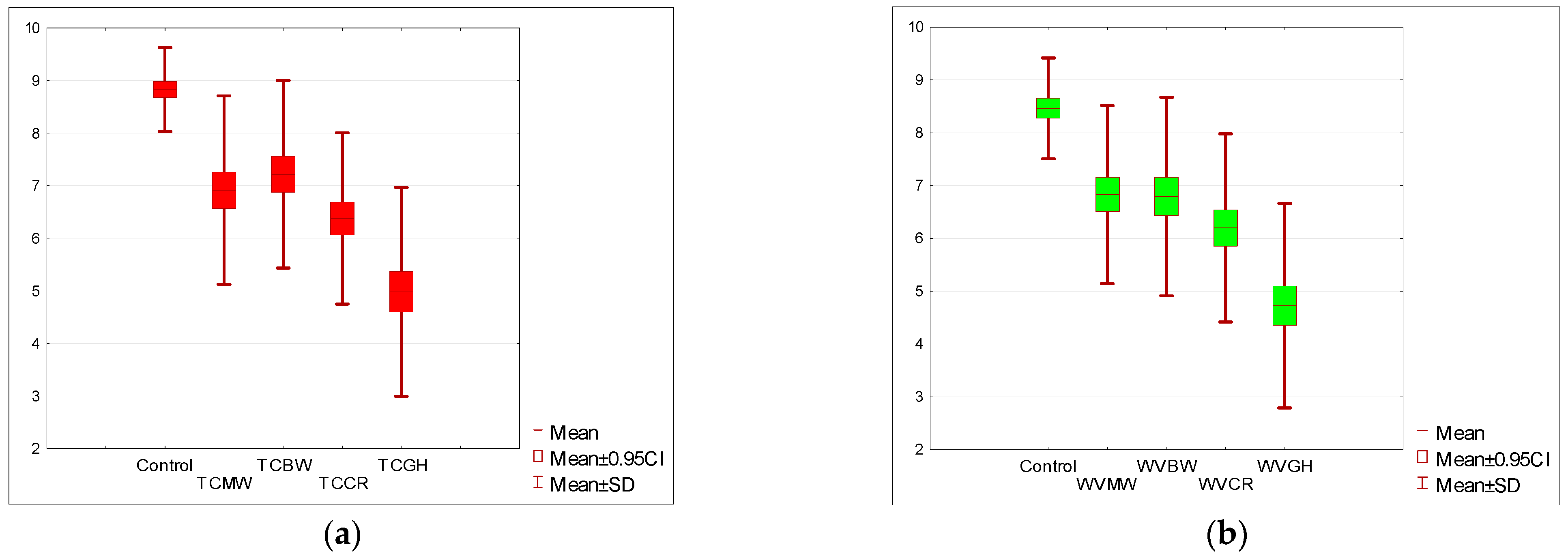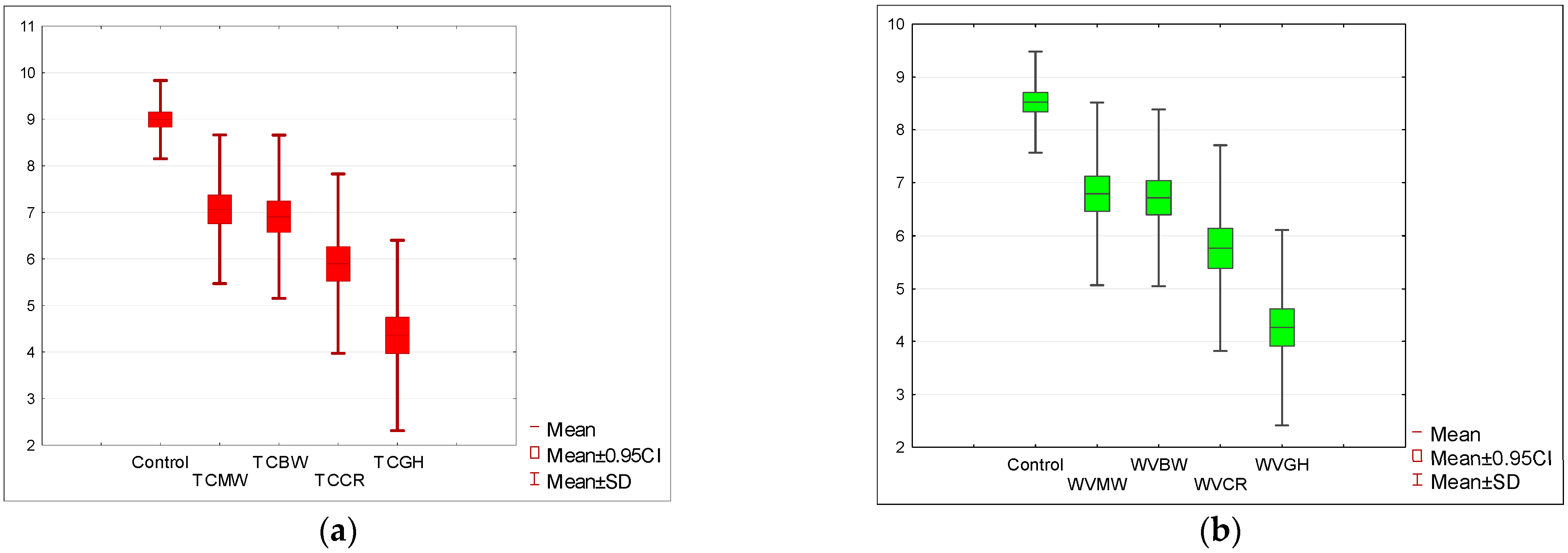The Acceptance of Cream Soups with the Addition of Edible Insects (Mealworm, T. molitor; House Cricket, A. domesticus; Buffalo Worm, A. diaperinus; Grasshopper, R. differens) among Young People and Seniors in Poland
Abstract
:1. Introduction
2. Materials and Methods
2.1. Materials
2.2. Preparation of Soup with Insect Flour
2.3. Chemical Composition
2.4. Characteristics of the Study Group
2.5. Consumer Acceptance Analysis
2.6. Statistical Analysis
3. Results
4. Discussion
5. Conclusions
Author Contributions
Funding
Institutional Review Board Statement
Informed Consent Statement
Data Availability Statement
Conflicts of Interest
References
- del Hierro, J.N.; Hernández-Ledesma, B.; Martin, D. Potential of edible insects as a new source of bioactive compounds against metabolic syndrome. In Current Advances for Development of Functional Foods Modulating Inflammation and Oxidative Stress; Elsevier: Amsterdam, The Netherlands, 2022; pp. 331–364. [Google Scholar]
- Boukid, F.; Sogari, G.; Rosell, C.M. Edible insects as foods: Mapping scientific publications and product launches in the global market (1996–2021). J. Insects Food Feed 2023, 9, 353–368. [Google Scholar] [CrossRef]
- Poma, G.; Cuykx, M.; Amato, E.; Calaprice, C.; Focant, J.F.; Covaci, A. Evaluation of hazardous chemicals in edible insects and insect-based food intended for human consumption. Food Chem. Toxicol. 2017, 100, 70–79. [Google Scholar] [CrossRef]
- Aguilar-Toalá, J.E.; Cruz-Monterrosa, R.G.; Liceaga, A.M. Beyond human nutrition of edible insects: Health benefits and safety aspects. Insects 2022, 13, 1007. [Google Scholar] [CrossRef] [PubMed]
- Meshulam-Pascoviche, D.; David-Birman, T.; Refael, G.; Lesmes, U. Big opportunities for tiny bugs: Processing effects on the techno-functionality and digestibility of edible insects. Trends Food Sci. Technol. 2022, 122, 265–274. [Google Scholar] [CrossRef]
- Żuk-Gołaszewska, K.; Gałęcki, R.; Obremski, K.; Smetana, S.; Figiel, S.; Gołaszewski, J. Edible Insect Farming in the Context of the EU Regulations and Marketing—An Overview. Insects 2022, 13, 446. [Google Scholar] [CrossRef] [PubMed]
- Skotnicka, M.; Karwowska, K.; Kłobukowski, F.; Borkowska, A.; Pieszko, M. Possibilities of the Development of Edible Insect-Based Foods in Europe. Foods 2021, 10, 766. [Google Scholar] [CrossRef] [PubMed]
- Maya, C.; Sterling, K.; Rukov, J.L.; Roos, N. Perception of edible insects and insect-based foods among children in Denmark: Educational and tasting interventions in online and in-person classrooms. J. Insects Food Feed 2023, 9, 89–1001. [Google Scholar] [CrossRef]
- Han, J.S.; Han, J.S. Improving awareness on edible insects through dietary education based on health belief model. Asian J. Beauty Cosmetol. 2020, 18, 549–558. [Google Scholar] [CrossRef]
- Guiné, R.P.; Florença, S.G.; Anjos, O.; Boustani, N.M.; Chuck-Hernández, C.; Sarić, M.M.; Ferreira, M.; Costa, C.A.; Bartkiene, E.; Cardoso, A.P.; et al. Are Consumers Aware of Sustainability Aspects Related to Edible Insects? Results from a Study Involving 14 Countries. Sustainability 2022, 14, 14125. [Google Scholar] [CrossRef]
- de Jong, B.; Nikolik, G. No Longer Crawling: Insect Protein to Come of Age in the 2020s. Rabo Bank Research. Available online: https://insectfeed.nl/wp-content/uploads/2021/03/Rabobank_No-Longer-Crawling-Insect-Protein-to-Come-of-Age-in-the-2020s_Feb2021-1.pdf (accessed on 11 April 2023).
- van Huis, A. Progress and challenges of insects as food and feed. In New Aspects of Meat Quality: From Genes to Ethics, 2nd ed.; Elsevier: Amsterdam, The Netherlands, 2022; pp. 533–557. [Google Scholar]
- Toti, E.; Massaro, L.; Kais, A.; Aiello, P.; Palmery, M.; Peluso, I. Entomophagy: A Narrative Review on Nutritional Value, Safety, Cultural Acceptance and A Focus on the Role of Food Neophobia in Italy. Eur. J. Investig. Health Psychol. Educ. 2020, 10, 628–643. [Google Scholar] [CrossRef]
- Papastavropoulou, K.; Xiao, J.; Proestos, C. Edible insects: Tendency or necessity (a review). eFood 2023, 4, e58. [Google Scholar] [CrossRef]
- Nowakowski, A.C.; Miller, A.C.; Miller, M.E.; Xiao, H.; Wu, X. Potential health benefits of edible insects. Crit. Rev. Food Sci. Nutr. 2022, 62, 3499–3508. [Google Scholar] [CrossRef] [PubMed]
- Ojha, S.; Bekhit, A.E.D.; Grune, T.; Schlüter, O.K. Bioavailability of nutrients from edible insects. Curr. Opin. Food Sci. 2021, 41, 240–248. [Google Scholar] [CrossRef]
- Lu, M.; Zhu, C.; Smetana, S.; Zhao, M.; Zhang, H.; Zhang, F.; Du, Y. Minerals in edible insects: Review of content and potential for sustainable sourcing. Food Sci. Hum. Wellness 2023, 13, 65–74. [Google Scholar] [CrossRef]
- Kosečková, P.; Zvěřina, O.; Pěchová, M.; Krulíková, M.; Duborská, E.; Borkovcová, M. Mineral profile of cricket powders, some edible insect species and their implication for gastronomy. J. Food Compos. Anal. 2022, 107, 104340. [Google Scholar] [CrossRef]
- Imathiu, S. Benefits and food safety concerns associated with consumption of edible insects. NFS J. 2020, 18, 1–11. [Google Scholar] [CrossRef]
- Siddiqui, S.A.; Zannou, O.; Karim, I.; Kasmiati Awad, N.M.; Gołaszewski, J.; Heinz, V.; Smetana, S. Avoiding food neophobia and increasing consumer acceptance of new food trends—A decade of research. Sustainability 2022, 14, 10391. [Google Scholar] [CrossRef]
- Hopkins, I.; Farahnaky, A.; Gill, H.; Danaher, J.; Newman, L.P. Food neophobia and its association with dietary choices and willingness to eat insects. Front. Nutr. 2023, 10, 1150789. [Google Scholar] [CrossRef]
- Sogari, G.; Menozzi, D.; Mora, C. The food neophobia scale and young adults’ intention to eat insect products. Int. J. Consum. Stud. 2019, 43, 68–76. [Google Scholar] [CrossRef]
- Borges, M.M.; da Costa, D.V.; Trombete, F.M.; Câmara, A.K.F.I. Edible insects as a sustainable alternative to food products: An insight into quality aspects of reformulated bakery and meat products. Curr. Opin. Food Sci. 2022, 46, 100864. [Google Scholar] [CrossRef]
- Kowalski, S.; Mikulec, A.; Mickowska, B.; Skotnicka, M.; Mazurek, A. Wheat bread supplementation with various edible insect flours. Influence of chemical composition on nutritional and technological aspects. LWT 2022, 159, 113220. [Google Scholar] [CrossRef]
- Pasini, G.; Cullere, M.; Vegro, M.; Simonato, B.; Dalle Zotte, A. Potentiality of protein fractions from the house cricket (Acheta domesticus) and yellow mealworm (Tenebrio molitor) for pasta formulation. LWT 2022, 164, 113638. [Google Scholar] [CrossRef]
- Amoah, I.; Cobbinah, J.C.; Yeboah, J.A.; Essiam, F.A.; Lim, J.J.; Tandoh, M.A.; Rush, E. Edible insect powder for enrichment of bakery products—A review of nutritional, physical characteristics and acceptability of bakery products to consumers. Future Foods 2023, 8, 100251. [Google Scholar] [CrossRef]
- Yazici, G.N.; Ozer, M.S. Using edible insects in the production of cookies, biscuits, and crackers: A review. Biol. Life Sci. Forum 2021, 6, 80. [Google Scholar]
- Carcea, M. Quality and nutritional/textural properties of durum wheat pasta enriched with cricket powder. Foods 2020, 9, 1298. [Google Scholar] [CrossRef]
- Sriprablom, J.; Kitthawee, S.; Suphantharika, M. Functional and physicochemical properties of cookies enriched with edible insect (Tenebrio molitor and Zophobas atratus) powders. J. Food Meas. Charact. 2022, 16, 2181–2190. [Google Scholar] [CrossRef]
- Kowalski, S.; Oracz, J.; Skotnicka, M.; Mikulec, A.; Gumul, D.; Mickowska, B.; Mazurek, A.; Sabat, R.; Wywrocka-Gurgul, A.; Żyżelewicz, D. Chemical Composition, Nutritional Value, and Acceptance of Nut Bars with the Addition of Edible Insect Powder. Molecules 2022, 27, 8472. [Google Scholar] [CrossRef]
- Ribeiro, J.C.; Santos, C.; Lima, R.C.; Pintado, M.E.; Cunha, L.M. Impact of defatting and drying methods on the overall liking and sensory profile of a cereal bar incorporating edible insect species. Future Foods 2022, 6, 100190. [Google Scholar] [CrossRef]
- Mishyna, M.; Chen, J.; Benjamin, O. Sensory attributes of edible insects and insect-based foods—Future outlooks for enhancing consumer appeal. Trends Food Sci. Technol. 2020, 95, 141–148. [Google Scholar] [CrossRef]
- Smarzyński, K.; Sarbak, P.; Musiał, S.; Jeżowski, P.; Piątek, M.; Kowalczewski, P.Ł. Nutritional analysis and evaluation of the consumer acceptance of pork pâté enriched with cricket powder—Preliminary study. Open Agric. 2019, 4, 159–163. [Google Scholar] [CrossRef]
- Orsi, L.; Voege, L.L.; Stranieri, S. Eating edible insects as sustainable food? Exploring the determinants of consumer acceptance in Germany. Food Res. Int. 2019, 125, 108573. [Google Scholar] [CrossRef] [PubMed]
- Ribeiro, J.C.; Gonçalves, A.T.S.; Moura, A.P.; Varela, P.; Cunha, L.M. Insects as food and feed in Portugal and Norway–cross-cultural comparison of determinants of acceptance. Food Qual. Prefer. 2022, 102, 104650. [Google Scholar] [CrossRef]
- Adeboye, A.O.; Fasogbon, B.M.; Adegbuyi, K. Formulation of vegetable soup powder from Clerodendrum volubile enriched with Macrotermes bellicosus (termite) flour. Int. J. Trop. Insect Sci. 2021, 41, 2071–2076. [Google Scholar] [CrossRef]
- Boyd, M.C. Cricket Soup: A Critical Examination of the Regulation of Insects as Food. Yale Law Policy Rev. 2017, 36, 17–22. [Google Scholar]
- Nantanga, K.K.M.; Amakali, T. Diversification of mopane caterpillars (Gonimbrasia belina) edible forms for improved livelihoods and food security. J. Arid. Environ. 2020, 177, 104148. [Google Scholar] [CrossRef]
- Thomas, A.O.; Olatunji, D.O. Consumer acceptability and nutrient content of Westwood (Cirina forda) larva-enriched Amaranthus hybridus vegetable soups. Afr. J. Food Sci. 2020, 14, 244–255. [Google Scholar]
- Bisconsin-Júnior, A.; Rodrigues, H.; Behrens, J.H.; da Silva, M.A.A.P.; Mariutti, L.R.B. “Food made with edible insects”: Exploring the social representation of entomophagy where it is unfamiliar. Appetite 2022, 173, 106001. [Google Scholar] [CrossRef]
- Myers, G.; Pettigrew, S. A qualitative exploration of the factors underlying seniors’ receptiveness to entomophagy. Food Res. Int. 2018, 103, 163–169. [Google Scholar] [CrossRef]
- Florença, S.G.; Guine, R.P.; Goncalves, F.J.; Barroca, M.J.; Ferreira, M.; Costa, C.A.; Correia, P.M.; Cardoso, A.P.; Campos, S.; Anjos, O.; et al. The motivations for consumption of edible insects: A systematic review. Foods 2022, 11, 3643. [Google Scholar] [CrossRef]
- Fornalik, A. Zakłady żywienia zbiorowego–pojęcie, klasyfikacja, status prawny. Przegl. Praw. Rol. 2023, 1, 161–177. [Google Scholar] [CrossRef]
- AOAC. Association of Official Analysis Chemists International. 2005 Official Methods of Analysis of AOAC International. Dostępne na. Available online: https://www.aoac.org/scientific-solutions/standards-and-official-methods/ (accessed on 3 August 2023).
- Tsurkan, M.V.; Voronkina, A.; Khrunyk, Y.; Wysokowski, M.; Petrenko, I.; Ehrlich, H. Progress in chitin analytics. Carbohydr. Polym. 2021, 252, 117204. [Google Scholar] [CrossRef] [PubMed]
- PN-EN ISO 5492:2009/A1:2017-02-. Available online: https://sklep.pkn.pl/pn-en-iso-5492-2009-a1-2017-02e.html (accessed on 15 August 2023).
- PN-ISO 11035:1999. Available online: https://sklep.pkn.pl/normy/pn-iso-11035-1999p.html (accessed on 15 August 2023).
- Pliner, P.; Hobden, K. Development of a scale to measure the trait of food neophobia in humans. Appetite 1992, 19, 105–120. [Google Scholar] [CrossRef] [PubMed]
- Arena, E.; Mazzaglia, A.; Selvaggi, R.; Pecorino, B.; Fallico, B.; Serranò, M.; Pappalardo, G. Exploring consumer’s propensity to consume insect-based foods. Empirical evidence from a study in Southern Italy. Appl. Syst. Inn. 2020, 3, 38. [Google Scholar] [CrossRef]
- Bakkaloğlu, Z. Edible insect consumption and Turkish consumers’ attitudes towards entomophagy. Int. J. Agric. Environ. Food Sci. 2022, 6, 165–171. [Google Scholar] [CrossRef]
- Rabadán, A.; Bernabéu, R. A systematic review of studies using the Food Neophobia Scale: Conclusions from thirty years of studies. Food Qual. Prefer. 2021, 93, 104241. [Google Scholar] [CrossRef]
- Kim, H.S.; Kim, Y.J.; Chon, J.W.; Kim, D.H.; Song, K.Y.; Kim, H.; Seo, K.H. Organoleptic Evaluation of the High-Protein Yoghurt containing the Edible Insect Oxya chinensis sinuosa (Grasshopper): A Preliminary Study. J. Milk Sci. Biotechnol. 2017, 35, 266–269. [Google Scholar] [CrossRef]
- Ros-Baró, M.; Sánchez-Socarrás, V.; Santos-Pagès, M.; Bach-Faig, A.; Aguilar-Martínez, A. Consumers’ Acceptability and Perception of Edible Insects as an Emerging Protein Source. Int. J. Environ. Res. Public Health 2022, 19, 15756. [Google Scholar] [CrossRef]
- Bae, Y.; Choi, J. Consumer acceptance of edible insect foods: An application of the extended theory of planned behavior. Nutr. Res. Pract. 2021, 15, 122–135. [Google Scholar] [CrossRef]
- Szendr Ho, K.; Tóth, K.; Nagy, M.Z. Opinions on insect consumption in Hungary. Foods 2020, 9, 1829. [Google Scholar] [CrossRef]
- Boehm, E.; Borzekowski, D.; Ververis, E.; Lohmann, M.; Böl, G.F. Communicating food risk-benefit assessments: Edible insects as red meat replacers. Front. Nutr. 2021, 8, 749696. [Google Scholar] [CrossRef]
- Biró, B.; Sipos, M.A.; Kovács, A.; Badak-Kerti, K.; Pásztor-Huszár, K.; Gere, A. Cricket-Enriched Oat Biscuit: Technological Analysis and Sensory Evaluation. Foods 2020, 9, 1561. [Google Scholar] [CrossRef] [PubMed]
- Villanueva, M.; Pérez-Quirce, S.; Collar, C.; Ronda, F. Impact of acidification and protein fortification on rheological and thermal properties of wheat, corn, potato and tapioca starch-based gluten-free bread doughs. LWT 2018, 96, 446–454. [Google Scholar] [CrossRef]
- Cappelli, A.; Oliva, N.; Bonaccorsi, G.; Lorini, C.; Cini, E. Assessment of the rheological properties and bread characteristics obtained by innovative protein sources (Cicer arietinum, Acheta domesticus, Tenebrio molitor): Novel food or potential improvers for wheat flour? LWT 2020, 118, 108867. [Google Scholar] [CrossRef]
- Khatun, H.; Lievens, S.; Smets, R.; Akhtaruzzaman, M.; Van Der Borght, M.; Claes, J. Optimizing the rheological and textural properties of chapatti enriched with house crickets (Acheta domesticus) flour using hydrocolloids by an I-optimal design. Foods 2022, 11, 3467. [Google Scholar] [CrossRef] [PubMed]
- Stojanova, M.; Pantic, M.; Klaus, A.; Mihajlovic, D.; Miletic, D.; Sobajic, S.; Stojanova, M.T.; Niksic, M. Bio soups—New functional dehydrated soups enriched with lyophilised Fuscoporia torulosa extracts. Int. J. Food Sci. Technol. 2023, 58, 3628–3636. [Google Scholar] [CrossRef]
- Mohamed, R.S.; Abozed, S.S.; El-Damhougy, S.; Salama, M.F.; Hussein, M.M. Efficiency of newly formulated functional instant soup mixtures as dietary supplements for elderly. Heliyon 2020, 6, e03197. [Google Scholar] [CrossRef]
- Pambo, K.O.; Okello, J.J.; Mbeche, R.; Kinyuru, J.N. Consumer Acceptance of Edible Insects for Non-Meat Protein in Western Kenya. Agecon Search. 2016. Available online: https://ageconsearch.umn.edu/record/246317/ (accessed on 10 October 2023).
- Çabuk, B.; Yılmaz, B. Fortification of traditional egg pasta (erişte) with edible insects: Nutritional quality, cooking properties and sensory characteristics evaluation. J. Food Sci. Technol. 2020, 57, 2750–2757. [Google Scholar] [CrossRef] [PubMed]
- Meyer-Rochow, V.B.; Hakko, H. Can edible grasshoppers and silkworm pupae be tasted by humans when prevented to see and smell these insects? J. Asia-Pac. Entomol. 2018, 21, 616–619. [Google Scholar] [CrossRef]
- Kim, Y.K.; Joen, J.C. Development of Yogurt Muffins with Addition of Mealworm Powder (Tenebrio molitor Lavare). Culin. Sci. Hosp. Res. 2019, 25, 47–51. [Google Scholar]
- Elhassan, M.; Wendin, K.; Olsson, V.; Langton, M. Quality aspects of insects as food—Nutritional, sensory, and related concepts. Foods 2019, 8, 95. [Google Scholar] [CrossRef]
- Mazurek, A.; Palka, A.; Skotnicka, M.; Kowalski, S. Consumer Attitudes and Acceptability of Wheat Pancakes with the Addition of Edible Insects: Mealworm (Tenebrio molitor), Buffalo Worm (Alphitobius diaperinus), and Cricket (Acheta domesticus). Foods 2022, 12, 1. [Google Scholar] [CrossRef] [PubMed]
- Ruby, M.B.; Rozin, P.; Chan, C. Determinants of willingness to eat insects in the USA and India. J. Insects Food Feed 2015, 1, 215–225. [Google Scholar] [CrossRef]
- Lim, S.M.; Thien, C.N.; Toure, A.K.; Poh, B.K. Factors Influencing Acceptance of Grasshoppers and Other Insects as Food: A Comparison between Two Cities in Malaysia. Foods 2022, 11, 3284. [Google Scholar] [CrossRef] [PubMed]
- Cruz-López, S.O.; Álvarez-Cisneros, Y.M.; Domínguez-Soberanes, J.; Escalona-Buendía, H.B.; Sánchez, C.N. Physicochemical and sensory characteristics of sausages made with grasshopper (Sphenarium purpurascens) flour. Foods 2022, 11, 704. [Google Scholar] [CrossRef]






| Kind of Insect | Moisture | Protein | Ash | Fat | Dietary Fiber g × 100 g−1 | |||
|---|---|---|---|---|---|---|---|---|
| Insoluble Fraction including Chitin | Chitin | Soluble Fraction | Total | |||||
| T. molitor | 1.56 ± 0.01 c | 45.39 ± 0.06 c | 3.86 ± 0.01 d | 14.29 ± 0.06 c | 11.56 ± 0.07 d | 6.93 ± 0.02 d | 0.36 ± 0.02 a | 11.92 ± 0.05 d |
| A. diaperinus | 5.40 ± 0.03 a | 49.51 ± 0.16 b | 4.71 ± 0.03 a | 26.44 ± 0.22 b | 12.96 ± 0.04 c | 7.33 ± 0.01 c | 0.00 ± 0.00 | 12.96 ± 0.04 c |
| A. domesticus | 2.47 ± 0.01 b | 55.18 ± 0.11 a | 4.34 ± 0.01 c | 29.01 ± 0.04 a | 18.48 ± 0.06 b | 9.92 ± 0.01 b | 0.24 ± 0.01 b | 18.72 ± 0.05 b |
| R. differens | 0.00 ± 0.00 | 42.96 ± 0.07 d | 4.48 ± 0.04 b | 9.60 ± 0.08 d | 19.94 ± 0.06 a | 10.83 ± 0.01 a | 0.00 ± 0.00 | 19.94 ± 0.06 a |
| Tomato Soup | ||||||||||
| Young | Seniors | |||||||||
| Descriptors | ||||||||||
| Kind of Edible Insects | Appearance | Odor | Taste | Structure | Acceptance | Appearance | Odor | Taste | Structure | Acceptance |
| Control | 9.38 ± 0.78 a | 8.90 ± 0.28 a | 8.28 ± 0.99 a | 9.06 ± 0.96 a | 9.04 ± 0.94 a | 9.18 ± 0.74 a | 8.75 ± 0.81 a | 8.48 ± 0.85a | 9.03 ± 0.85 a | 8.95 ± 0.75 a |
| TCMW | 7.66 ± 1.79 b | 6.90 ± 1.84 c | 6.62 ± 2.04 b | 7.11 ± 1.83 b | 7.18 ± 1.52 b | 7.30 ± 1.68 b | 6.03 ± 1.77 c | 6.46 ± 1.96 b | 6.84 ± 1.97 b | 6.98 ± 1.66 b |
| TCBW | 7.34 ± 1.87 b | 7.28 ± 1.75 b | 6.78 ± 2.20 b | 6.93 ± 1.95 c | 6.98 ± 1.87 c | 7.18 ± 1.74 c | 7.16 ± 1.83 b | 6.51 ± 2.13 b | 6.93 ± 1.99 b | 6.84 ± 1.65 b |
| TCCR | 6.76 ± 1.91 c | 6.48 ± 1.88 d | 5.64 ± 2.22 c | 5.98 ± 2.02 d | 6.04 ± 2.02 d | 6.36 ± 1.49 d | 6.29 ± 1.38 c | 5.45 ± 1.83 c | 5.91 ± 1.77 c | 5.77 ± 1.86 c |
| TCGH | 5.52 ± 2.25 d | 4.61 ± 2.10 e | 3.96 ± 2.19 d | 4.74 ± 2.33 e | 4.38 ± 2.27 e | 5.16 ± 1.90 e | 4.48 ± 1.88 d | 4.59 ± 1.90 d | 4.48 ± 2.12 d | 4.34 ± 1.84 d |
| Soup with White Vegetables | ||||||||||
| Young | Seniors | |||||||||
| Descriptors | ||||||||||
| Kind of Edible Insects | Appearance | Odor | Taste | Structure | Acceptance | Appearance | Odor | Taste | Structure | Acceptance |
| Control | 9.06 ± 0.87 a | 8.48 ± 0.99 a | 8.36 ± 1.10 a | 8.48 ± 1.05 a | 8.60 ± 0.97 a | 9.07 ± 0.87 a | 8.45 ± 0.92 a | 8.47 ± 1.00 a | 8.18 ± 1.03 a | 8.42 ± 0.95 a |
| WVMW | 7.48 ± 2.03 b | 7.02 ± 1.79 b | 6.78 ± 2.03 b | 6.94 ± 2.03 b | 6.98 ± 1.74 b | 6.80 ± 1.96 b | 6.66 ± 1.59 b | 6.30 ± 1.95 b | 6.52 ± 1.95 b | 6.63 ± 1.70 b |
| WVBW | 7.22 ± 1.96 c | 6.96 ± 1.84 b | 6.78 ± 1.84 b | 7.02 ± 1.69 b | 6.86 ± 1.68 b | 6.86 ± 2.07 b | 6.64 ± 1.92 b | 6.40 ± 1.91 c | 6.71 ± 1.91 c | 6.59 ± 1.66 b |
| WVCR | 6.54 ± 1.96 d | 6.10 ± 2.07 c | 5.55 ± 2.41 c | 6.02 ± 1.95 c | 5.90 ± 2.03 c | 5.93 ± 1.61 c | 6.29 ± 1.49 c | 5.41 ± 1.92 d | 5.77 ± 1.96 d | 5.64 ± 1.87 c |
| WVGH | 4.68 ± 1.72 e | 4.47 ± 1.89 d | 3.72 ± 1.75 d | 4.09 ± 1.77 d | 4.31 ± 1.86 d | 4.98 ± 1.87 d | 4.78 ± 1.99 d | 3.55 ± 1.90 e | 4.96 ± 1.99 e | 4.23 ± 1.85 d |
| Kind of Soup | Acceptance | All | Young | Seniors | p |
|---|---|---|---|---|---|
| Tomato soup (STC) | Control | 9.02 ± 0.91 | 9.04 ± 0.94 | 8.95 ± 0.75 | 0.359 |
| TCMW | 7.10 ± 1.72 | 7.18 ± 1.52 | 6.98 ± 1.66 | 0.647 | |
| TCBW | 6.90 ± 1.87 | 6.98 ± 1.87 | 6.84 ± 1.65 | 0.682 | |
| TCCR | 5.92 ± 2.08 | 6.04 ± 2.02 | 5.77 ± 1.86 | 0.699 | |
| TCGH | 4.40 ± 2.11 | 4.38 ± 2.27 | 4.34 ± 1.84 | 0.839 | |
| White vegetable soup (SWV) | Control | 8.61 ± 0.95 | 8.60 ± 0.97 | 8.42 ± 0.95 | 0.438 |
| WVMW | 6.82 ± 1.80 | 6.98 ± 1.74 | 6.63 ± 1.70 | 0.296 | |
| WVBW | 6.73 ± 1.73 | 6.86 ± 1.68 | 6.59 ± 1.66 | 0.352 | |
| WVCR | 5.72 ± 2.34 | 5.90 ± 2.03 | 5.64 ± 1.87 | 0.527 | |
| WVGH | 4.27 ± 1.90 | 4.31 ± 1.86 | 4.23 ± 1.85 | 0.700 |
| Type of Additive | Regression Equation | R2 |
|---|---|---|
| Control (SPC) | y = 0.31x1 + 0.05x2 + 0.29x3 + 0.35x4 | 0.99 |
| T. molitor (TCMW) | y = 0.33x1 + 0.14x2 + 0.28x3 + 0.25x4 | 0.99 |
| A. diaperinus (TCBW) | y = 0.19x1 + 0.16x2 + 0.31x3 + 0.34x4 | 0.99 |
| A. domesticus (TCCR) | y = 0.15x1 − 0.05x2 + 0.59x3 + 0.31x4 | 0.98 |
| R. differens (TCGH) | y = 0.07x1 + 0.06x2 + 0.61x3 + 0.26x4 | 0.97 |
| Control (SWV) | y = 0.34x1 − 0.09x2 + 0.28x3 + 0.45x4 | 0.99 |
| T. molitor (WVMW) | y = 0.26x1 + 0.16x2 + 0.22x3 + 0.35x4 | 0.99 |
| A. diaperinus (WVBW) | y = 0.17x1 + 0.18x2 + 0.29x3 + 0.34x4 | 0.99 |
| A. domesticus (WVCR) | y = 0.24x1 + 0.07x2 + 0.41x3 + 0.25x4 | 0.98 |
| R. differens (WVGH) | y = 0.02x1 + 0.37x2 + 0.59x3 + 0.06x4 | 0.98 |
Disclaimer/Publisher’s Note: The statements, opinions and data contained in all publications are solely those of the individual author(s) and contributor(s) and not of MDPI and/or the editor(s). MDPI and/or the editor(s) disclaim responsibility for any injury to people or property resulting from any ideas, methods, instructions or products referred to in the content. |
© 2023 by the authors. Licensee MDPI, Basel, Switzerland. This article is an open access article distributed under the terms and conditions of the Creative Commons Attribution (CC BY) license (https://creativecommons.org/licenses/by/4.0/).
Share and Cite
Skotnicka, M.; Mazurek, A.; Kowalski, S. The Acceptance of Cream Soups with the Addition of Edible Insects (Mealworm, T. molitor; House Cricket, A. domesticus; Buffalo Worm, A. diaperinus; Grasshopper, R. differens) among Young People and Seniors in Poland. Nutrients 2023, 15, 5047. https://doi.org/10.3390/nu15245047
Skotnicka M, Mazurek A, Kowalski S. The Acceptance of Cream Soups with the Addition of Edible Insects (Mealworm, T. molitor; House Cricket, A. domesticus; Buffalo Worm, A. diaperinus; Grasshopper, R. differens) among Young People and Seniors in Poland. Nutrients. 2023; 15(24):5047. https://doi.org/10.3390/nu15245047
Chicago/Turabian StyleSkotnicka, Magdalena, Aleksandra Mazurek, and Stanisław Kowalski. 2023. "The Acceptance of Cream Soups with the Addition of Edible Insects (Mealworm, T. molitor; House Cricket, A. domesticus; Buffalo Worm, A. diaperinus; Grasshopper, R. differens) among Young People and Seniors in Poland" Nutrients 15, no. 24: 5047. https://doi.org/10.3390/nu15245047
APA StyleSkotnicka, M., Mazurek, A., & Kowalski, S. (2023). The Acceptance of Cream Soups with the Addition of Edible Insects (Mealworm, T. molitor; House Cricket, A. domesticus; Buffalo Worm, A. diaperinus; Grasshopper, R. differens) among Young People and Seniors in Poland. Nutrients, 15(24), 5047. https://doi.org/10.3390/nu15245047







